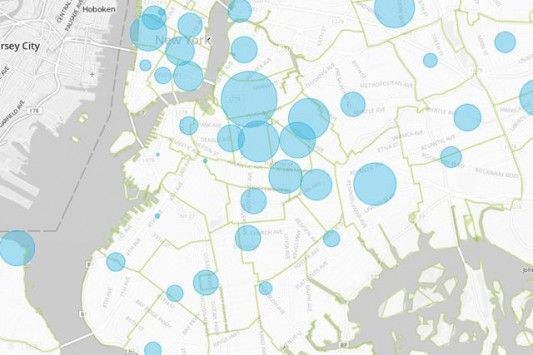The Summons Issue


The New York World (“get inside your government”) just released a report on the geography of the city’s 350,000 pink slips — NYPD-issued summonses for minor and minor-ish infractions like public drinking, unreasonable noise, marijuana possession, and reckless driving. Like the NYPD’s racially-charged (or at least, racially complicated) stop and frisk policies, these “quality-of-life summonses” — disproportionately issued in heavily non-white communities — are beginning to “garner scrutiny on similar grounds.”
Along with the article, (which is far more nuanced than this blog post, and which you should read here), they’ve built an interactive map of summons data, which charts each precinct’s pink slip stats.
Because the NYPD collects the demographic info for individuals receiving summonses, but doesn’t release that data publicly, any one precinct’s numbers are revealing only in contrast to other precincts. In other words: we don’t know the actual breakdown of the 1,000+ summonses in the 67th precinct (Flatbush) issued in 2011, but we do know that the area is 99% black and Hispanic.
The 78th precinct in Park Slope, on the other hand, has so few total summonses (and, perhaps not inconsequentially, so many white people) that it’s used as a point of contrast — 67% white, 16 summonses for disorderly conduct last year.
Summonses in the 78th Precinct from 2011
Open Container/Public Drinking: 23
Disorderly Conduct: 16
Bicycle on Sidewalk: 6
Public Urination: 6
Trespassing: 7
Failure to Comply Sign in a Park: 1
Driving in Violation of Safety Rules: 1
Reckless Driving: 4
Littering of Liquids: 5
In Parks after Hours: 0
Unlawful Possession of Marijuana: 0
Driving without a License: 1
Unreasonable Noise: 1
Unlicensed General Vendor: 4
Driving with Suspended Registration: 1
Of course, taken alone, those numbers don’t reveal much — which is part of the problem the report is addressing. What does one even make of the single unreasonable noise summons of 2011, which is all but uninterpretable — are we quiet? Do the police generally look the other way because everything’s probably fine? Do complaints get defused before summonses are issued? Is that because the area’s 67% white and relatively affluent?
Like stop-and-frisks, summonses are often incredibly subjective, to the point where “some criminal defense lawyers in the city say they’ve seen disorderly conduct charges used as a kind of policing panacea — a catch-all charge officers can use against behavior they don’t like.” There’s a lot of wiggle room in “disorderly conduct” (there are at least eight legal definitions), and the decision to issue a summons for, say being in a park after hours depends an awful lot on the police officer’s individual judgement.
But while no one’s arguing the laws are (or should be) cut and dried, not that everyone thinks their enforcement has racist undertones. Heather Mac Donald, a fellow at the Manhattan Institute, argues that the high-summons rates in more troubled and/or less white neighborhoods are actually an example of “proactive policing” that benefits everyone. “The positive effects far outweigh the inconveniences of being stopped when you’re innocent and I don’t think it’s racism that’s sending cops to these neighborhoods. It’s high crime,” she says, adding that “people [in poorer neighborhoods] have the same right to order in the streets as they do on Park Avenue.”
(Of course, as in the stop-and-frisk debate, the difference between “inconvenience” and “violation of civil liberties” has a lot to do with where you’re standing.)
The NYPD, for their part, declined to comment.




